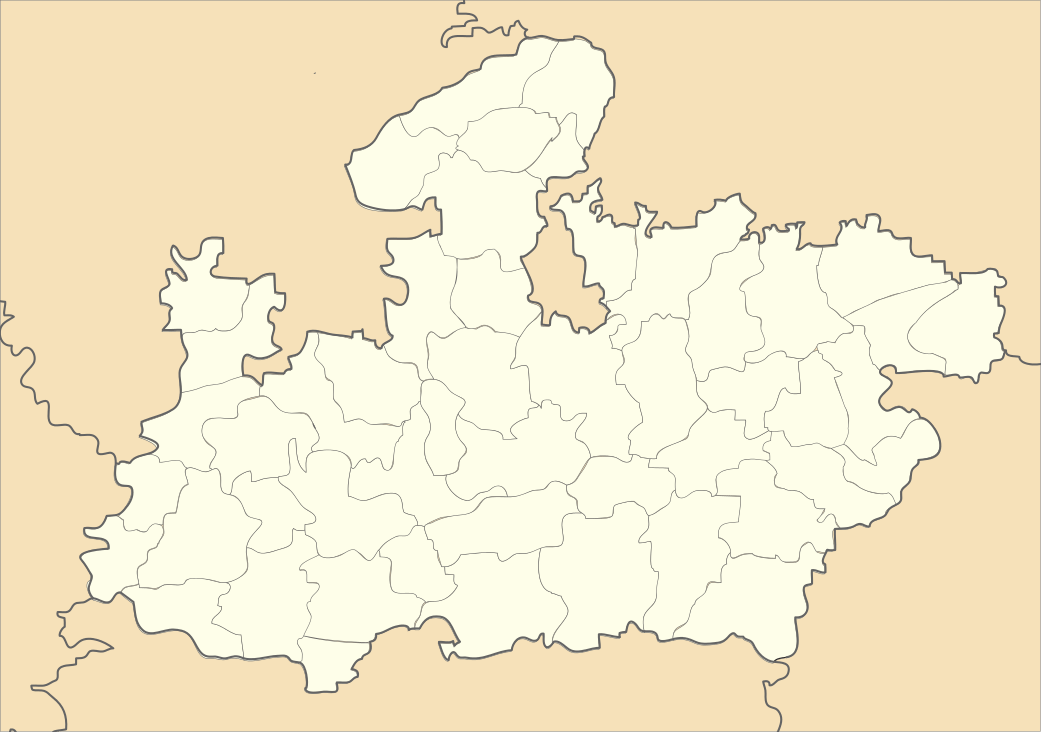Patalkot, India
| Patalkot | |
|---|---|
| Town | |
 Patalkot Location in Madhya Pradesh, India | |
| Coordinates: 22°15′N 78°28′E / 22.25°N 78.46°ECoordinates: 22°15′N 78°28′E / 22.25°N 78.46°E | |
| Country |
|
| State | Madhya Pradesh |
| District | Chhindwara |
| Tehsil | Tamia tehsil |
| Languages | |
| • Official | Hindi |
| Time zone | IST (UTC+5:30) |
| Vehicle registration | MO- |
| Website |
www |
Patalkot (Sanskrit for "very deep") is a valley in the Tamia tehsil of Chhindwara district in Madhya Pradesh, India.
Geography
The Patalkot valley is spread over an area of 79 km2. at an average height of 2750–3250 feet above Mean Sea Level from 22.24 to 22.29 ° North and 78.43 to 78.50 ° East. The valley is located at a distance of 78 km from Chhindwara in the North-West direction and 20 km from Tamia in the North-East Direction. 'Doodhi' river flows in the picturesque valley. This horse–shoe shaped valley is surrounded by giant hills and there are several pathways to reach the villages located inside the valley.
Patalkot is a completely hidden valley that is cut from the civilized world- Dr Deepak Acharya
History
'Patalkot' name comes from Sanskrit word "Patal" that means very deep. There is a belief that after worshipping 'Lord Shiva', Prince Meghnath son of Ravana had gone to Patal-lok through this place only. People say that Kings ruled this place in the 18th and 19th Centuries and that there was a long tunnel connecting this place to Pachmarhi in Hoshangabad District. Traditionally, the site is believed to be the entrance to Patal. This valley had long been cut off from the civilized culture outside and was discovered only few years back. Patalkot has been a home to a tribal culture and custom since its origin.
Tourism

In recent years, the government has been trying to make Patalkot an eco-tourism destination because of its geographical and scenic beauty.[1] Patalkot remains highly alluring and gorgeousness during the rains. The monsoon season is a popular time to visit this place, as it is sheltered, with clouds all around. Patalkot is very close to nature and adivasi culture is alive here, though this may change with increased impact from tourism and outside pressures. Patalkot is famous for retaining its original culture and customs for a long time. Until a few years back, it was a world in its own with absolutely no influence from outside.
This deep valley is situated on the way to Bhopal from Chhindwara. Patalkot is 78 km away from Chhindwara, on a diversion route towards Tamia. It can be reached through taxi from Chhindwara. There is no facility of accommodation in the valley, the nearest accommodation facility is in Tamia at the forest or PWD guest house. Patalkot is a good place for tourism of M.P.
Culture
There are in total 12 villages and 13 hamlets with a total population of 2012 (1017 male and 995 female) in the valley. These villages are located at the distance of 2–3 km each. The main villages of the valley are: Rated, Chimtipur, Gujja Dongri, Sahra Pachgol, Harra-ka-Char, Sukhabhand, Dhurni malni, Jhiram, Palani Gaildubba, Ghatlinga, Gudichattri, Gaildubba, Kareyam, Ghana, etc.
Gonds (Gondi people) and Bharias mainly constitute the population of Patalkot. It is said that Bharias have been living here for more than 500 years. Tribal men, women and children wear traditional dresses during their festive times and enjoy it. Chulki, Mundri, Binoria, Toda, Hasli, Kardona, Paijan, Mohanmala, Kushmala, Mungiamala, Markadhana mala and Patli are the common ornaments they show off at this time. Tribals perform prayers and rituals every day. The place where they perform Pooja (prayer) is called as Devghar. Tribals worship Mahadev, Badadev, Madai, Madmi Mai, Doolhadev, Nandia, Surjadev, Agiadev as their gods and goddesses. Nagda, Timki, Shehnai, Chakule, Singa, Tambura, Chikara, Bansuri, Ghunghru, Khadtaal, Madar, Dhol, Dahak and Tudiya are the common instruments they play during various ceremonies and rituals.
As mentioned by Dr Deepak Acharya in an article published in ECOS MAGAZINE- Australia Wisdom from the Heart of India, Patalkot is home to a tribal culture and custom. The valley is such a beautiful place now facing threats of deforestation.
Medicines and Herbs
Patalkot is the home of a few rare medicinal plants and herbs. They include Abrus precatorius, Aloe vera, Annona squamosa, Bryonia lacinosa, Aegle marmelos, Madhuca indica, Ficus racemosa, Holoptelea integrifolia, Lawsonia enermis, Tylophora asthmatica, Gloriosa superba, Gymnema sylvestre, Hemidesmus indicus, etc. The tribes of Patalkot are skilled at using the forest plants to make effective medicines. The herbal practitioners are known as Bhumkas. They are unusually skilled at making pulps and extracts of plants for curing illnesses. They have medicinal treatments for many illnesses including, measles, cholera, hypertension, diabetes, coughs, snake bites, and even pains (Acharya and Shrivastava, 2008).
Due to the exposure of Patalkot's herbal treasure to the outside world, the eco-balance of the valley is in grave danger. The system of the valley that encompasses several villages and their lives has been self-sustained over a long period of time. Now, the Patalkot valley craves for getting its balance back, stop the deforestation and help retain the eco-system and culture of the valley alive.
References
2. Acharya, Deepak and Shrivastava Anshu (2008): Indigenous Herbal Medicines: Tribal Formulations and Traditional Herbal Practices, Aavishkar Publishers Distributor, Jaipur- India. ISBN 978-81-7910-252-7. pp 440.
External links
| ||||||||||||||||||||||||||||||||||||||